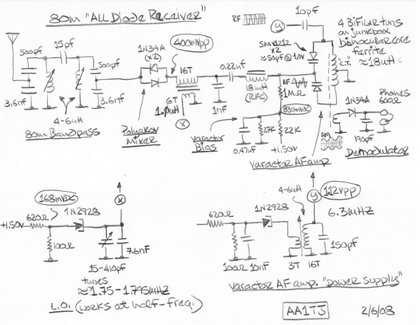This direct-conversion receiver uses a sub-harmonic (Polyakov) mixer with a tunnel diode local oscillator. It uses a varactor-based audio amplifier that's energized by a second tunnel diode oscillator. The varactor audio amplifier is somewhat novel, although I first noticed this idea in an article dating back to the early 1950's. In a nutshell; the resonant frequency of an LC tank circuit is modulated by the incoming AF signal. A diode demodulates the resulting AM signal.
I chose to use a tunnel diode pumped varactor amplifier instead of a tunnel diode negative resistance amplifier for a number of reasons. A "straight" tunnel diode amplifier is a reciprocal device; whereas the varactor amplifier is unidirectional. Also, stability of a tunnel diode amplifier is inversely proportional to the gain. The setting for a modestly high gain is dangerously close to the threshold of oscillation (Ouch!). Furthermore, a Germanium tunnel diode amplifier has a small dynamic range, and an even smaller range for linear signal reproduction.
Here are two short audio clips that I recorded on 80m last evening with this receiver. Both DX stations were roughly an S5 in my headphones; perfectly readable, even with this one stage of audio amplification.
This receiver was paired with my tunnel diode transmitter to make an all tunnel diode station. On 2/5/08 I used the pair to make a QSO with AA1MY, Seab, at a distance of 100 miles. This may be the first ham radio contact with a station using diodes as the only active devices.
